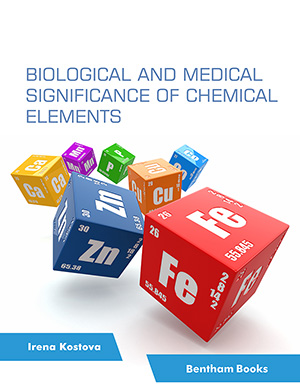Abstract
Background: Benzimidazoles are important heterocyclic compounds having significant attention in the pharmacological industry due to their various biological and dying properties.
Objective: 3-(1H-benzo[d]imidazol-2-yl)-2-chloroquinoline, a heterocyclic dye (1), was prepared using o-phenylenediamine and 2-chloroquinoline-3-carbaldehyde in the presence of ceric ammonium nitrate catalyst and hydrogen peroxide under reflux condition, which was subjected to mordant and disperse dyeing study and antimicrobial activity to develop antimicrobial textile garment products.
Methods: Elemental analysis, NMR, FT-IR, Mass and UV-visible spectroscopic techniques were used to characterize dye (1). Polyester, wool and silk textile fabrics were selected for the evaluation of dyeing assessment of dispersed heterocyclic dye. The in vitro antimicrobial screening was done against Mycobacterium tuberculosis H37Rv, Streptococcus pyogenes, Staphylococcus aureus, Pseudomonas aeruginosa, Escherichia coli, Candida albicans, Aspergillus niger and Aspergillus clavatus strains using standard drugs as reference.
Results: The deep brown to green shades were observed for dye (1), particularly on polyester samples and showed excellent wash fastness and light fastness properties. Dye (1) was active against Staphylococcus aureus showing 100 μgmL-1 MIC with 16.5 mm ZOI better than the reference drug ampicillin. It was more active against Candida albicans with 12.5, μgmL-1 MIC with 33 mm ZOI in compared to nystatin reference drug during antifungal screening. In primary screening, the MIC value for antimycobacterial activity was <12.5 μgmL-1.
Conclusion: The characteristics values of spectroscopic data support the chemical structure of dye (1). It may become the potent applicant for the production of antimicrobial textile garment products like socks, stockings, caps, etc. due to its fastness, lightning and antimicrobial activity results.
Keywords: Antimicrobial activity, benzimidazole, dyeing property, fastness properties, mordant textile dyeing, fluorescent.
[http://dx.doi.org/10.1021/cr60151a002]
[http://dx.doi.org/10.1016/S0896-8446(00)00065-6]
[http://dx.doi.org/10.1111/cote.12199]
[http://dx.doi.org/10.1016/j.bmcl.2008.05.009] [PMID: 18486471]
[http://dx.doi.org/10.1016/j.bmcl.2007.10.106] [PMID: 18039577]
[http://dx.doi.org/10.1081/NCN-120023123] [PMID: 14565505]
[http://dx.doi.org/10.1016/S0014-827X(02)01300-9] [PMID: 12420877]
[http://dx.doi.org/10.1016/j.bmcl.2010.01.147] [PMID: 20188544];
b) Refaat, H.M. Synthesis and anticancer activity of some novel 2-substituted benzimidazole derivatives. Eur. J. Med. Chem., 2010, 45(7), 2949-2956.
[http://dx.doi.org/10.1016/j.ejmech.2010.03.022] [PMID: 20399544];
c) Shaharyar, M.; Abdullah, M.M.; Bakht, M.A.; Majeed, J. Pyrazoline bearing benzimidazoles: Search for anticancer agent. Eur. J. Med. Chem., 2010, 45(1), 114-119.
[http://dx.doi.org/10.1016/j.ejmech.2009.09.032] [PMID: 19883957];
d) Gellis, A.; Kovacic, H.; Boufatah, N.; Vanelle, P. Synthesis and cytotoxicity evaluation of some benzimidazole-4,7-diones as bioreductive anticancer agents. Eur. J. Med. Chem., 2008, 43(9), 1858-1864.
[http://dx.doi.org/10.1016/j.ejmech.2007.11.020] [PMID: 18222567];
e) Thimmegowda, N.R.; Nanjunda Swamy, S.; Kumar, C.S.A.; Kumar, Y.C.S.; Chandrappa, S.; Yip, G.W.; Rangappa, K.S. Synthesis, characterization and evaluation of benzimidazole derivative and its precursors as inhibitors of MDA-MB-231 human breast cancer cell proliferation. Bioorg. Med. Chem. Lett., 2008, 18(1), 432-435.
[http://dx.doi.org/10.1016/j.bmcl.2007.08.078] [PMID: 17981032];
f) Demirayak, S.; Abu Mohsen, U.; KuCağri Karaburunmar, A. ynthesis and anticancer and anti-HIV testing of some pyrazino[1,2- a]benzimidazole derivatives. Eur. J. Med. Chem., 2002, 37(3), 255-260.
[http://dx.doi.org/10.1016/S0223-5234(01)01313-7] [PMID: 11900869]
[http://dx.doi.org/10.1016/S0020-7519(01)00131-X] [PMID: 11400692]
[http://dx.doi.org/10.1021/jm00120a002] [PMID: 2848124]
[http://dx.doi.org/10.1002/jctb.280620209]
[http://dx.doi.org/10.1016/j.farmac.2003.12.001] [PMID: 14871499]
[http://dx.doi.org/10.1016/0584-8539(91)80042-H];
b) Sundaraganesan, N.; Ilakiamani, S.; Subramani, P.; Joshua, B.D. Comparison of experimental and ab initio HF and DFT vibrational spectra of benzimidazole. Spectrochim. Acta A Mol. Biomol. Spectrosc., 2007, 67(3-4), 628-635.
[http://dx.doi.org/10.1016/j.saa.2006.08.020] [PMID: 16979935]
[http://dx.doi.org/10.1016/j.jorganchem.2011.11.016]































